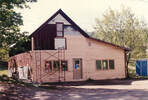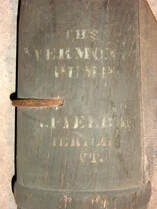History of the Jericho Historical Society
By Gary Irish
© 2021 Town of Jericho, Vermont*
Used with permission of the Jericho Town History Committee
Click to enlarge most images.
© 2021 Town of Jericho, Vermont*
Used with permission of the Jericho Town History Committee
Click to enlarge most images.
In September 1969, members of the Lucky Shamrock 4-H Club received a grant from the Reader’s Digest Foundation to be used to promote interest in local heritage, information about local history and to call attention to the needs of the community. Their first step was to collect material concerning noted Jericho icon Wilson A. “Snowflake” Bentley.
The leader of this group was Elaine White, and members included Mary Blades, Joan Alexander, Norma Bister, Donna Bister, Laura, Mary and Martha Alexander, Becky Bister, Martha and Mary Blades, Barbara Conners, Mary Jacobs, Brenda Lawrence Lynda Valyou, Wendi Chamberlain, Barbara Packard, Cathy Mobbs and Mary Lou Chaffee.
|
At Town Meeting in March 1971, the selectmen were authorized to appoint a Jericho Historical Committee, and Perry Kinsley was appointed chairman, with Myrna Lindholm as clerk, and members Wayne Alexander, Louis Peck and Blair Williams. By June of that year, the Lucky Shamrock 4-H Club became concerned about the possible disposition of the Chittenden Mills flour mill in Jericho Corners, which had closed in 1946, and became used as part of the automobile service station in front of it. Rumors were that it might be coming up for sale, and perhaps someone was going to remodel it into a restaurant. With the old mill being such an icon in town, this idea did not sit well, and so on June 10th the club organized an evening of slides, songs and dramatic presentations, called the Jericho Album. Their expressed desire was “in hopes of raising money to rebuild the dam at the Old Mill, and perhaps, in time, to secure the Old Mill for the town.” [1]
|
With the fear of something happening to the mill, and the sentiment to do something, on August 9, 1971, the Jericho Historical Society was officially formed with Perry Kinsley as temporary chairman. The recommendation from the selectmen (Donald Fay, Wayne Alexander and Elwood Clark) was as follows:
“Whereas, there are a number of items of historical interest in the town and: Whereas, no organization now exists for the purpose of preservation of these articles and: Whereas, it is important that the remembrances of man be recorded, regarding the history of Jericho: We hereby recommend the formation of a Jericho Historical Society."
On August 24, by-laws were accepted, and officers were elected as follows:
- President – Blair Williams
- Vice President – George Pearce
- Treasurer – Henry Fuyat
- Secretary – Myrna Lindholm
- Directors – 2 year term – Ed Bacon, Mildred Buxton, David Jordan, 1 year term – Louis Peck, Morris Gittleson
In December 1971, the historical society took a $1000 option to purchase the mill and water rights, good until July 31, 1972, along with first refusal on the house and garage. At Town Meeting in March 1972, an article to allocate $5000 toward rebuilding the mill dam was defeated. In July, a letter was received from Senator George Aiken saying that Chittenden Mills had been placed on the National Register of Historic Sites.
In the summer of 1972, a flash flood washed out the back corner of the mill’s wheelhouse, which was no longer protected by the mill dam. Men were working on the Route 15 bridge in front of the mill, and Alonzo “Skip” Bennett, owner of the mill, was able to make arrangements with them to repair the damage to the wheelhouse wall and add a cement retaining wall at the back of the wheelhouse to protect it from further damage. [2]
Meanwhile, the historical society had been busy with fundraising, fact finding, engineering surveys and drawing up renovation specifications. The hope was to turn the building into a community center. Funding had been received from the National Trust for Historic Preservation, IBM, and many individuals, both local and from further away. The project had been covered on local TV, as well as in Vermont Life magazine and the Society for Industrial Archeology publications. The time on the option was extended until Town Meeting 1973. Article 4 on the warning for the meeting of March 6, 1973, asked the town of Jericho to purchase the mill, dam site, water rights and four acres of land at a total cost of $42,000. As the society had already paid $1000, the remainder was to be paid by the town, $6000 the first year and $5000 per year for the next seven years. The article was approved by a vote of 188 to 86, as was article 5, which asked the town to lease the mill to the historical society for $1 per year for the next 25 years. The historical society was able to get a $10,500 grant from the Eva Gebhard Gourgaud Foundation which reduced the town’s share of the purchase cost. [3, 4]

4 – Rebuilding the Route 15 bridge in front of the mill in 1972. During the repairs, the state reduced the road to one lane, with
a traffic light to control traffic flow, and at times, historical society members would stand out beside the stopped cars
with buckets soliciting donations to go toward the purchase of the mill.
a traffic light to control traffic flow, and at times, historical society members would stand out beside the stopped cars
with buckets soliciting donations to go toward the purchase of the mill.
While Skip Bennett still owned the mill, Connie Pousland and Jean Jordan had started a craft shop in the front room of the mill. On July 1, 1973, the historical society purchased the craft shop from Connie and Jean for $1125.10, and continues to operate it with volunteers as a means of raising funds. Jean Smith became the first manager of the shop, followed by Willie Cochran on June 1, 1975, and since 1991, Gail Prior has held the position.
The society started renovations on the mill as funding permitted, tackling the most pressing items, such as leaks in the roof first. Some funding, especially federal money, was available, but it most often required a local match. The society found that the value of the mill could be used as a match, so they went back to the town, and on March 4, 1974 the town voted at Town Meeting to transfer ownership of the mill to the historical society, which allowed the society to obtain further funds for restoration and renovation.
|
After flour making at the mill ceased in 1904, the flour making machinery was sold. The roller mills which were one of the unique modern features of the mill in 1885, had been made by the Case Manufacturing Co. of Columbus, Ohio. This company was only in business for a short time, so this type of machinery was quite uncommon. In early 1974, the society became aware of a mill, the Pleasant Valley Roller Mills in West Leesport, Pennsylvania, that was to be taken down by the US Army Corps of Engineers as part of the Blue Marsh Lake Project, which was flooding a valley to create a water supply and recreation area for Reading, Pennsylvania. And the mill contained four double stands of Case roller mills, almost identical to those originally in Chittenden Mills! The Corps of Engineers put the equipment up for sealed bids, and the society bid not only on the roller mills, but several other pieces of equipment as well. [5, 6]
|
But all but one of their bids was rejected because they were below the minimum bids the corps had established. However, the society was the only bidder, so nothing was sold. The corps did a second round of bidding, with minimums either reduced or eliminated, and the second time the society was the winner on all except one piece of equipment, and at a lower cost than their first round bids. Then the issue was how to get this equipment back to Vermont. Gary Irish, who had orchestrated the purchase of the equipment, then gathered a group of volunteers to go to Pennsylvania and dismantle everything to get it ready to ship. This happened over several weekends, each time leaving Vermont about 1 am on a Friday morning, driving all night to arrive mid-morning, get the key to the mill, and work all day Friday and Saturday and part of the day on Sunday, then drive back to Vermont Sunday evening. At first it was a hard job to convince the Corp of Engineers to let us do this, as they had no experience dealing with a group of volunteers, but eventually they were persuaded to allow us to do it. We would pick the key up at their office in Bernville, a few miles from the mill, and then drop it off at a restaurant in town on Sunday, where they could pick it up the next day, after we were back in Vermont.
Finally, everything was dismantled and we were ready to ship. We had made arrangements with Norton Trucking in Essex. This was operated by Ralph Norton, who had grown up in Jericho. September 27, 1974, a tractor trailer showed up at the Pleasant Valley mill at 6 am, and the group of volunteers spent from then until after dark loading equipment. This included the four Case roller mills, with their line shaft, a bran duster, two flour packers, one of which was identical to what had been in Chittenden Mills, Fairbanks platform scales identical to the set that had been in our mill, plus all of the flour elevators needed for the mill and several conveyors and pieces of shafting. We had also purchased the flour sifter. This was about 4 x 11 feet in size, with a large gearbox/weight in the center, and was located on the second floor of the mill. So to move it, we had removed the gearbox from the body of the sifter. By dark we had loaded all except the sifter body into the truck, and with no electricity in the mill and everyone being exhausted, we decided to leave the sifter body. The truck left, driving all night and arriving in Jericho the next morning, where another group of volunteers unloaded the equipment. [7, 8, 9]
On October 19, we made another trip to Pennsylvania to bring home the flour sifter, using a borrowed pickup truck. Upon loading the sifter into the truck, it was so heavy that the rear tires were nearly squashed flat. We started on our way back to Vermont, but could not go very fast, as the truck would otherwise sway badly. We had not gone more than 20 or 30 miles before we had a flat tire. We found a garage to help us, and found that the tires on the truck were not nearly heavy duty enough for the weight of the sifter. So we had to purchase both two new tires and two new rims, as the heavy tires would not fit the rims on the truck. But eventually we were off again and very slowly made our way home.
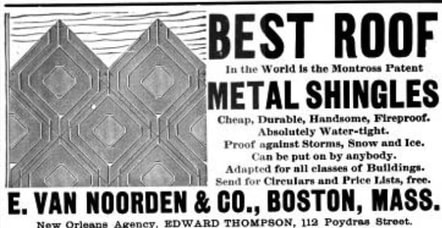 10 – Advertisement from the March 19, 1886 issue of the Northwestern Miller for the Montross Patent metal shingles that Lucien Howe used on Chittenden Mills.
10 – Advertisement from the March 19, 1886 issue of the Northwestern Miller for the Montross Patent metal shingles that Lucien Howe used on Chittenden Mills.
A major problem that the society had to tackle was the condition of the mill roof. It and the upper sidewalls of the mill were covered with the Montross patent metal shingles that Lucien Howe had purchased in Boston, likely from the E. Van Noorden Company, during his trip there in early August, 1885. [10] Soon after acquiring the mill, temporary repairs had been made, but it was obvious that something more permanent had to be done if the building was to be preserved. At first there was discussion of replacing the roofing with standing seam metal, but while appropriate to the time period, this was not authentic to the building, and would greatly change its historic appearance. Taking a couple of the original shingles with him, Hugh Irish talked with a machine shop owner in St. Albans, and found that it would be practical to have dies made to replicate the original shingles. With this information, in 1978, the society found a shop, Haag Manufacturing Co. in Burlington, that could make the dies. The next step was to find appropriate metal. The original had been steel with a naturally occurring tin content, but this was no longer available. The closest substitute available was terne coated steel and this was supplied by the Follansbee Steel Co. of Follansbee, West Virginia. The shingles were stamped out by New England Air Systems. [11]
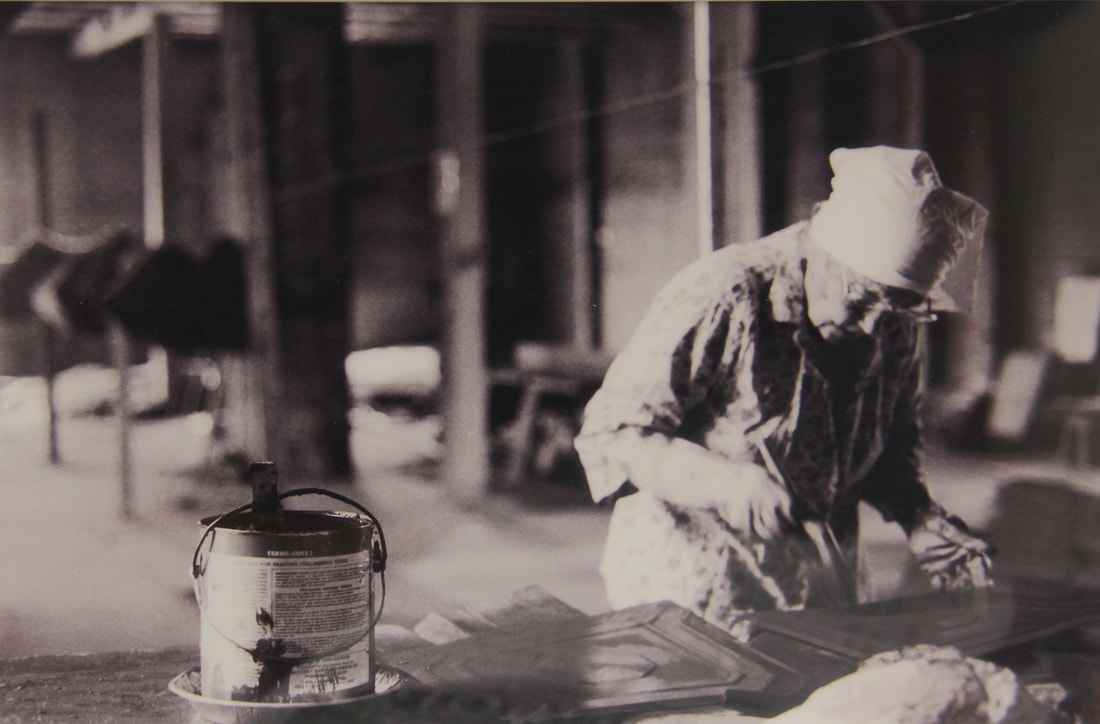
11 – After the historical society had replicas of the original shingles made, they all had to be painted with primer before they could be installed on the mill roof. This picture shows Blair Williams doing this, and above her head and in the background, you can see the wire with freshly painted shingles hung on it to dry.
|
|
15 – [left] Replica of the original finial that was on the very top of the main elevator tower when it was built in 1885, but which had long since been removed. This showed in old photos, so Gary Irish took one of these photos and was able to measure it under a microscope to determine the original dimensions, and this replica was made by Larry Stearns from Johnson and installed by Harraseeket when they replaced the tower roofing. The rod seen at the bottom both helps attach it to the building and is a connection to the lightening rod system. |
|
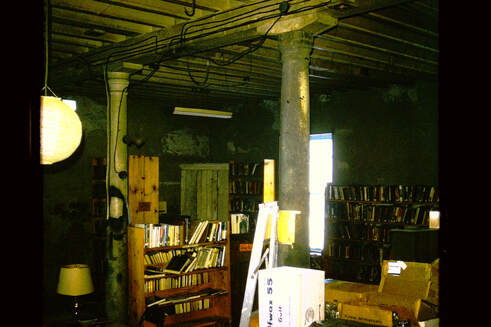 19 – Brown’s River Library, sometimes known as the Jericho Village Library and which for years was sponsored by the Brown’s River Study Club, when it was in the middle room of the mill. It was in this space from 1973 to 1976. The photo is from March 21, 1974. This was known as the middle room, as at that time the original wall which divided the first floor of the main building into two rooms was still in place. That was later removed, along with the stairs to the second floor, when the new flooring was installed on the first floor.
19 – Brown’s River Library, sometimes known as the Jericho Village Library and which for years was sponsored by the Brown’s River Study Club, when it was in the middle room of the mill. It was in this space from 1973 to 1976. The photo is from March 21, 1974. This was known as the middle room, as at that time the original wall which divided the first floor of the main building into two rooms was still in place. That was later removed, along with the stairs to the second floor, when the new flooring was installed on the first floor.
Besides operating the craft shop, the society also remodeled other parts of the mill building to house rental space to support ongoing restoration and maintenance. In 1973, the rear section was rented to Brown’s River Bindery, operated by Charles and Janet Remy, and Gary van Vlanderin, who operated a woodworking shop. Through the years, the mill has also housed David Drew’s law office, The Flower Mill florist, and Saxon Hill preschool. The middle room in the mill was renovated for a variety of uses, and named the Blair Williams Room, in honor of the lady who had done so much for both the historical society and the town in general. For a time it housed the Brown’s River Library, it was used for community meetings, and was also used for many years by the Northern Vermont Artists Association to display artworks created by their members. [19]
|
In 1978, the historical society purchased the former miller’s house beside the mill, along with an additional four acres of land, once again reuniting the property. Following the purchase the barn behind the mill house was remodeled and used by the Brown’s River Bindery, then later by Saxon Hill preschool for many years. The house at times housed office space, but has mostly been rented as apartments. And work has continued on restoration of the buildings the society owns. [20, 21, 22, 23, 24]
|
|
Besides the primary focus of the society, the preservation of Chittenden Mills, the society has been active in other areas. In 1973, to celebrate the acquisition of the mill, the society held an open house on August 11 to officially transfer the lease from the town to the society. This became an annual event, with “Old Mill Day” being held on August 10, 1974, with not only an open house at the mill, but a parade and craft people at the Jericho elementary school. The 1975 celebration included a tug of war across Brown’s River behind the mill between the Underhill-Jericho Fire Department and the Richmond Fire Department, followed by a dinner in Jericho Center and games and dancing on the green. [25] In 1979, Old Mill Day included tours of historic homes in town. By 1980, the celebration had been renamed “Jericho Day”, to encourage broader participation in the celebration, but with limited volunteers to do the work and increasing competition from the United Church of Underhill’s Harvest Market, held just a month later, it was celebrated for only a few more years.
|
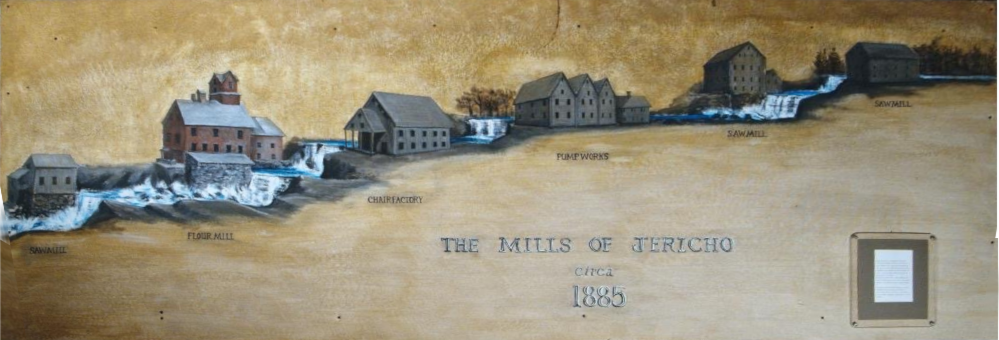
26 – This is an illustration of the various mills that were once on the Brown’s River in Jericho Corners which was done by Rob Towne, at that time an officer of the society, for the museum. It shows, from left to right, the Curtis sawmill on water power #1, Chittenden Mills on site #2, then it skips site #3, which was inaccessible and never used, then water power #4, the Jericho Chair Factory, site #5, the Field’s pump works, site #6, a sawmill where lumber was both sawn for commercial sale and also to supply the pump works, and site #7, variously used for a saw mill, a box factory, where boxes were made for the cheese factory at Riverside, and an oil mill, where flax seeds were pressed to make linseed oil.
In 1981, the society opened a museum in the basement of the mill. This included a panoramic painting of the Brown’s River [26], showing the mills once powered by the river, as well as displaying items manufactured in those mills. This consisted of a display of products made in the mill, along with chairs made in the Jericho chair factory, a water pump and wooden pipe made in the pump factory, and milling equipment both from this mill and items from the Pennsylvania mill. Also included was a display of Snowflake Bentley items. For a time, the bell formerly in the woolen mill in Jericho Corners, and later for many years in the Underhill ID school was also included. [27 - 33]

27 – The museum that the society created in the mill basement in 1981 as seen on March 13, 1983. Although a poor photo, one can see the flour packers in the center distance, one of the line of roller mills on the right, and on the left a display of the silks from the Wolf Level Sifter that the society had acquired from the Pleasant Valley Roller Mills. These sorted the grist from the roller mills into different categories, sending some to another roller mill, some to the flour bin, and some to the bran duster.

33 – The bell originally in Barney’s woolen mill, which was across the river from the mill on water power #1. The bell was made in West Troy, NY. This was later used in the Underhill ID school in Underhill Flats for many years, and is now mounted outside of the second ID school building in Riverside, currently the home of the Chittenden East school offices. The bell first called workers to the mill, and later students to classes. Note the large wooden pulley which would attach to the left side of the bell, engaging the bracket on the bell, and the hole in this pulley so the flange of the bell would clear it. This was loaned to the historical society for display in the museum.
One of the most important activities of the society has been the preservation of the legacy of Jericho’s most famous son Wilson “Snowflake” Bentley. For many years the society visited schools with a presentation on Bentley, to acquaint children with his work. Several attempts were made by the society to have the US Post Office issue a commemorative stamp to honor Mr. Bentley, but each time they were turned down, and the stamp never happened. The society has also collected any Bentley artifacts that have become available, and now owns not just his original camera and microscope that he used to take his over 5000 photos with, but also has many of his original notebooks in which he recorded his observations through the years. Starting in 1993, the society has, thanks to the work of Ray Miglionico, produced limited edition prints from Bentley’s original negatives, most of which are now housed at the Buffalo Museum of Science in Buffalo, NY. Besides spreading awareness of Bentley’s work, these prints are an important source of revenue for the society.
Through the years, the society has sponsored various other events, including a variety of historic programs by the Fairbanks Planetarium, Shelburne Museum, and an antiques appraisal, dinners both at the mill and at historic homes in town, and walking tours of the village being just some examples. [34 - 41] The society continues with their mission today, both preserving the Chittenden Mills complex as a Jericho icon, the legacy of Snowflake Bentley, and general aspects of Jericho history for future generations. [42]

42 – The Vermont Division for Historic Preservation sign erected at the mill in 1997 to recognize the mill’s historic importance. The text on the sign was written by Gary Irish. Since the time this was installed, the abutment for the former covered bridge failed, necessitating the removal of the “present footbridge” mentioned on the sign. The highway bridge was widened to add a footbridge there in its place.
*Alexander, Jessica, Stuart Alexander, J. Brooks Buxton, Terry Hook, Gary Irish, Barry King, and Phyl Newbeck, eds. The History of Jericho Vermont Volume Three 1963-2013. Burlington, VT: Queen City Printers. 2021
Layout adjusted from original printed publication for web presentation and to include images not in the original printed version.
Layout adjusted from original printed publication for web presentation and to include images not in the original printed version.


















